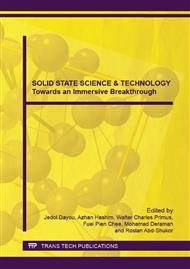[1]
A.K. Geim, K.S. Novoselov, The rise of graphene, Nature Mater. 6 (2007) 183-191.
Google Scholar
[2]
K.S. Novoselov, A.K. Geim, S.V. Morozov, D. Jiang, Y. Zhang, S.V. Dubonos, I.V. Grigorieva, A.A. Firsov, Electric field effect in atomically thin carbon films, Science 306 (2004) 666-669.
DOI: 10.1126/science.1102896
Google Scholar
[3]
T. Ohta, A. Bostwick, T. Seyller, K. Horn, E. Rotenberg, Controlling the electronic structure of bilayer graphene, Science 313 (2006) 951-954.
DOI: 10.1126/science.1130681
Google Scholar
[4]
R.M. Westervelt, Graphene nanoelectronics, Science 320 (2008) 324-325.
Google Scholar
[5]
K.S. Novoselov, Z. Jiang, Y. Zhang, S.V. Morozov, H.L. Stormer, U. Zeitler, J.C. Maan, G.S. Boebinger, P. Kim, A.K. Geim, Room-temperature quantum Hall effect in graphene, Science 315 (2007) 1379.
DOI: 10.1126/science.1137201
Google Scholar
[6]
S. Stankovich, D.A. Dikin, G.H.B. Dommett, K.M. Kohlhaas, E.J. Zimney, E.A. Stach, R.D. Piner, S.T. Nguyen, R.S. Ruoff, Graphene-based composite materials, Nature 442 (2006) 282-286.
DOI: 10.1038/nature04969
Google Scholar
[7]
D.A. Dikin, S. Stankovich, E.J. Zimney, R.D. Piner, G.H.B. Dommett, G. Evmenenko, S.T. Nguyen, R.S. Ruoff, Preparation and characterization of graphene oxide paper, Nature 448 (2007) 457-460.
DOI: 10.1038/nature06016
Google Scholar
[8]
D. Li, R.B. Kaner, Graphene-based materials, Science 320 (2008) 1170-1171.
Google Scholar
[9]
C. Lee, X. Wei, J.W. Kysar, J. Hone, Measurement of the elastic properties and intrinsic strength of monolayer graphene, Science 321 (2008) 385-388.
DOI: 10.1126/science.1157996
Google Scholar
[10]
J.S. Bunch, A.M. van der Zande, S.S. Verbridge, I.W. Frank, D.M. Tanenbaum, J.M. Parpia, H.G. Craighead P.L. McEuen, Electromechanical resonators from graphene sheets, Science 315 (2007) 490-493.
DOI: 10.1126/science.1136836
Google Scholar
[11]
A.A. Balandin, S. Ghosh, W. Bao, I. Calizo, D. Teweldebrhan, F. Miao, C.N. Lau, Superior thermal conductivity of single-layer graphene, Nano Lett. 8 (2008) 902-907.
DOI: 10.1021/nl0731872
Google Scholar
[12]
S. Park, R.S. Ruoff, Chemical methods for production of graphenes, Nature Nanotech. 4 (2009) 217-224.
DOI: 10.1038/nnano.2009.58
Google Scholar
[13]
M. Eizenberg, J.M. Blakely, Carbon monolayer phase condensation on Ni(111), Surf. Sci. 82 (1970) 228-236.
DOI: 10.1016/0039-6028(79)90330-3
Google Scholar
[14]
T. Aizawa, R. Souda, S. Otani, Y. Ishizawa, C. Oshima, Anomalous bond of monolayer graphite on transition-metal carbide surfaces, Phys. Rev. Lett. 64 (1990) 768-771.
DOI: 10.1103/physrevlett.64.768
Google Scholar
[15]
K.N. Kudin, B. Ozbas, H.C. Schniepp, R.K. Prud'homme, I.A. Aksay, R. Car, Raman spectra of graphite oxide and functionalized graphene sheets, Nano Lett. 8 (2008) 36-41.
DOI: 10.1021/nl071822y
Google Scholar
[16]
A.C. Ferrari, J.C. Meyer, V. Scardaci, C. Casiraghi, M. Lazzeri, F. Mauri, S. Piscanec, D. Jiang, K.S. Novoselov, S. Roth, A.K. Geim, Raman spectrum of graphene and graphene layers, Phys. Rev. Lett. 97 (2006) 187401.
DOI: 10.1103/physrevlett.97.187401
Google Scholar
[17]
G.X. Wang, J. Yang, J.S. Park, X.I. Gou, B. Wang, H. Liu, J. Yao, Facile synthesis and characterization of graphene nanosheets, J. Phys. Chem. C 112 (2008) 8192-8195.
DOI: 10.1021/jp710931h
Google Scholar
[18]
A.C. Ferrari, J. Robertson, Interpretation of Raman spectra of disordered and amorphous carbon, Phys. Rev. B 61 (2000) 14095-14107.
DOI: 10.1103/physrevb.61.14095
Google Scholar
[19]
J.L. Zhang, H.J. Yang, G.X. Shen, P. Cheng, J.Y. Zhang, S.W. Guo, Reduction of graphene oxide via L-ascorbic acid, Chem. Comm. 46, (2010) 1112-1114.
DOI: 10.1039/b917705a
Google Scholar
[20]
S. Bose, T. Kuila, M.E. Uddin, N.H. Kim, A.K.T. Lau, J.H. Lee, In-situ synthesis and characterization of electrically conductive polypyrrole/graphene nanocomposites, Polymer 2010, 51, 5921-5928.
DOI: 10.1016/j.polymer.2010.10.014
Google Scholar


